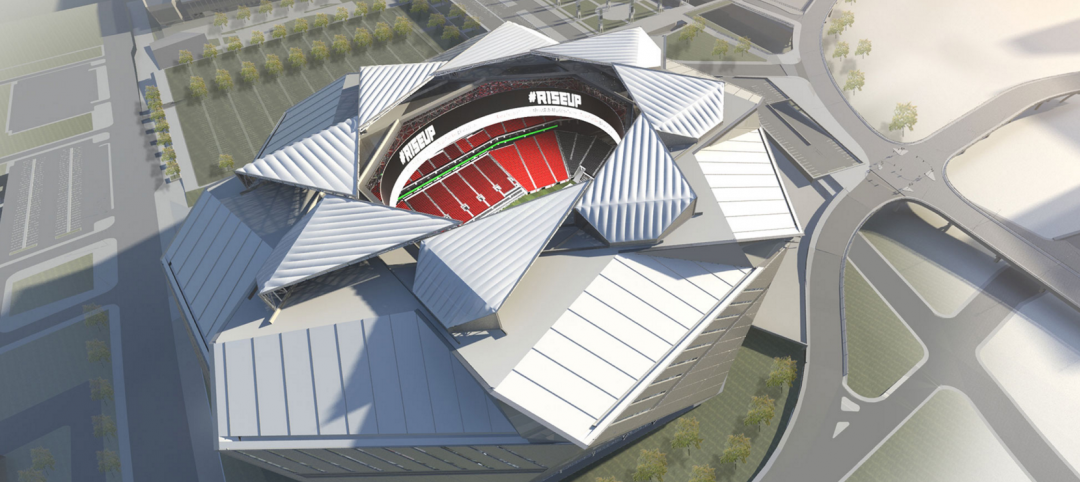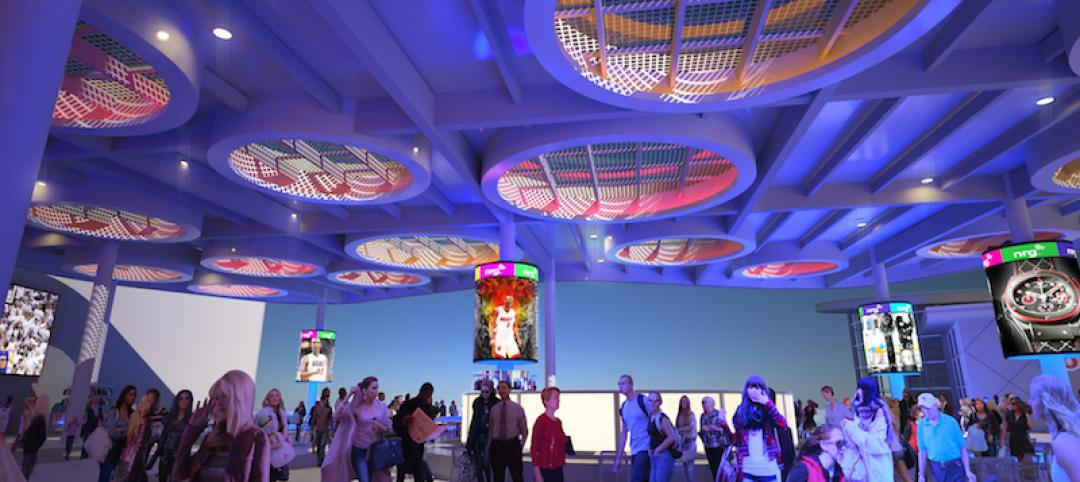Last winter, basketball fans at Oracle Arena, then-home to the Golden State Warriors, were introduced to the PlayStation game God of War. In an elaborate, multimedia promotion, animated content took over the arena’s massive, overhanging score board and ribbon displays. It then transitioned to the basketball court itself, which turned into a snowy dystopia of projected light as the game’s characters battled in front of the sold-out crowd and countless viewers watching online and on TV.
As amazing as it was at the time, this type of projection show — using audiovisual (AV) and digital technologies to transform sports venues into new experiences — has become much more prominent. Venues are effectively using applied video as a design element. For many years, arenas have staged such shows on a temporary basis, but now more are designing the technological capability into their facilities on a permanent basis. What’s known in the AV and production industries as “projection mapping” is becoming as integral to sports venue design as digital signage and public address systems. The video content can be as varied as player profiles and promotion or sponsor marketing and engagement.
“When we do hockey ice or basketball court projection, we try to create fan engagement,” explains Mark Ouwerkerk, Director of Events and Staging for Christie Digital Systems, which makes many of the projectors and supporting technologies used in arenas. “We’re trying to get people more involved in what we’re presenting, because we believe the visual images are what they remember.”

How Projection Mapping Works
Projection mapping is the process of presenting visual content on non-traditional surfaces, such as three-dimensional objects, the outside of buildings, or on basketball courts. At the 2018 Major League Baseball All-Star Game at Nationals Park in Washington, D.C., technologists even projection-mapped the stadium’s infield. At one point, the U.S. Capitol appeared to rise from home plate.
Projection mapping combines powerful projectors, media servers, computer software, and video content to create a unique, immersive show. It’s considered mapping because the specialized software takes the visual content — usually from multiple projectors — and shapes it to fit the target surface, precisely placing (mapping) the video pixels and creating the illusion that the content has been painted virtually onto the court, ice, or infield. The system intelligently combines video streams, and often blends, warps, or otherwise manipulates the video into a uniform, digital canvas. For example, in the case of projection mapping onto an ice rink, the video perfectly fits the surface’s rounded corners and light does not spill into the seats.
“The more complex,” says Ouwerkerk, “the more technology required.” In existing arenas, he says, the positioning of elements like scoreboards and other permanent fixtures can determine where projectors must be placed and how much processing will be applied to the content to compensate for odd angles and ensure the video looks perfect.
Design Considerations
Quince Imaging, projection-mapping specialists based in Sterling, Virginia, executed the Oracle Arena and Nationals Park productions and have worked in professional and college sports venues throughout the United States. Scott Williams, Quince Imaging’s co-founder and chief operating officer says that by now, virtually every major arena has staged a projection-mapping production, but less than one-quarter have built the capability into the venue’s infrastructure as a permanent feature. Doing so takes planning and coordination among design, construction, and technology teams.
“For existing arenas, we do an engineering analysis and study and get our technical plan approved to ensure the structure can hold the system the way we intend to install it,” Williams says. “More recently, for new venues, we’ve been working with construction firms like Samet Corp. and Turner Construction at the very beginning, when it’s still in the design phase, to integrate the desired projection-mapping system in the early stages. That way we can plan for power, signal, structure, weight, and methodology, and it works very smoothly.”
Installed projection-mapping systems are usually purpose-built — specified and installed to support the intended content and experience, but not usually repurposed or reconfigured for other uses. When incorporated into a venue’s design, today’s projection-mapping systems are often treated as lighting. The same way a lighting designer creates a plot to evenly illuminate the venue, AV integrators ensure a sufficient number of projectors, installed in the right locations, will bathe the target surface in video light.

Systems Vary in Size
In sports arenas, a typical projection-mapping installation can include eight to 12 large projectors and cost $750,000 to $1 million or more, which more teams and venues see as a sound investment toward creating an exceptional live experience. Quince Imaging recently installed 18 projectors at PNC Arena in Raleigh, North Carolina, home to the NHL’s Carolina Hurricanes and college’s N.C. State Wolfpack. “They wanted the best system, designed to be the brightest, highest-resolution system in sports,” Williams says. “And it is.”
The size and scope of a projection-mapping system depends on the content the venue intends to project and characteristics of the venue itself. For example, professional sports arenas often require more projectors than college sports arenas because they must overcome ambient light from other digital signage, which teams may be contractually required to keep illuminated even when a projection show is taking place. And because ice rinks are larger than basketball courts, they typically require more projection.
Quince Imaging worked with Monumental Sports & Entertainment on Capital One Arena, which supports Washington, D.C. hockey and basketball teams. The turnkey system, which consisted of 12 high-brightness 4K-resolution projectors, maps 2D and 3D content onto the ice for the Capitals and onto the court for the Wizards, adjusting to the different size of each surface.
Mapping Exterior Surfaces
And that’s just the inside of sports venues. The next frontier will be projection mapping on the exterior of arenas and stadia. For example, Little Caesars Arena in Detroit was designed with a curved, metal-canvas “skin” on 600 feet of its outer wall. Venue operators use 12 projectors to “paint” it with digital branding, advertising, and feeds from events inside the arena. In London, AV technologists turned the roof of the O2 Arena into an enormous projection surface (16,000 square meters) with a staggering 68 projectors putting out 1.4 million lumens of light.
“Projecting on arena facades takes an installed system, too, and can be thought of like lighting or digital signage,” says Quince Imaging’s Williams. “When the venue is hosting 200 different events a year it creates an engaging experience for visitors.”
As AV technology evolves, designers can expect projection mapping solutions to be more colorful, vibrant, lifelike, and interactive. Eventually, with tracking technology, fans will be able to play games on the ice or court. “Real-time fan engagement is the next great trend in this industry,” says Williams. “We’re in territory now where we’ve never been before.”
Related Stories
Industry Research | Feb 22, 2016
8 of the most interesting trends from Gensler’s Design Forecast 2016
Technology is running wild in Gensler’s 2016 forecast, as things like virtual reality, "smart" buildings and products, and fully connected online and offline worlds are making their presence felt throughout many of the future's top trends.
Game Changers | Feb 5, 2016
Mega surf parks take entertainment to new extremes
Wave-making technologies vie for attention, as surfing is shortlisted for 2020 Olympic Games.
Game Changers | Feb 4, 2016
GAME CHANGERS: 6 projects that rewrite the rules of commercial design and construction
BD+C’s inaugural Game Changers report highlights today’s pacesetting projects, from a prefab high-rise in China to a breakthrough research lab in the Midwest.
Sponsored | Sports and Recreational Facilities | Feb 3, 2016
New $96.5 million Ole Miss Basketball Arena Opened in January
The recently constructed basketball arena at Ole Miss, The Pavilion, exudes sophistication due to its spectacular curved roof coated with a vibrant Terra Cotta Fluropon.
Sports and Recreational Facilities | Jan 29, 2016
Billion-dollar dome in Las Vegas could be the Oakland Raiders next home
The franchise, which is considering relocation if it can’t work out a stadium deal in the Bay Area, is listening to a new stadium pitch from investors in Las Vegas, led by the Sands Corp.
Giants 400 | Jan 29, 2016
SPORTS FACILITIES GIANTS: Populous, AECOM, Turner among top sports sector AEC firms
BD+C's rankings of the nation's largest sports sector design and construction firms, as reported in the 2015 Giants 300 Report
| Jan 14, 2016
How to succeed with EIFS: exterior insulation and finish systems
This AIA CES Discovery course discusses the six elements of an EIFS wall assembly; common EIFS failures and how to prevent them; and EIFS and sustainability.
Sports and Recreational Facilities | Jan 13, 2016
Multi-billion-dollar stadium planned as the NFL returns to Los Angeles
The Rams, formerly of St. Louis, will move into a new stadium possibly by 2019—and they might have a co-tenant.
Sports and Recreational Facilities | Jan 8, 2016
Washington Redskins hire Bjarke Ingels Group to design new stadium
The Danish firm is short on designing football stadiums, but it has led other impressive large scale projects.
Sports and Recreational Facilities | Jan 6, 2016
A solar canopy makes Miami’s arena more functional
NRG Energy teams with Miami Heat to transform an underused open-air plaza and reinforce the facility’s green reputation

















